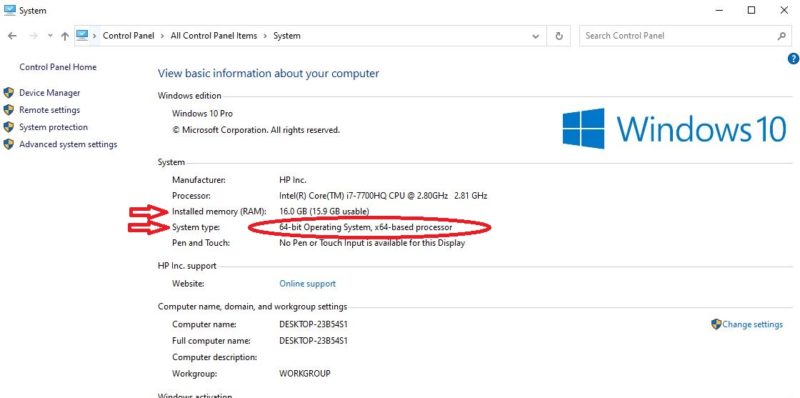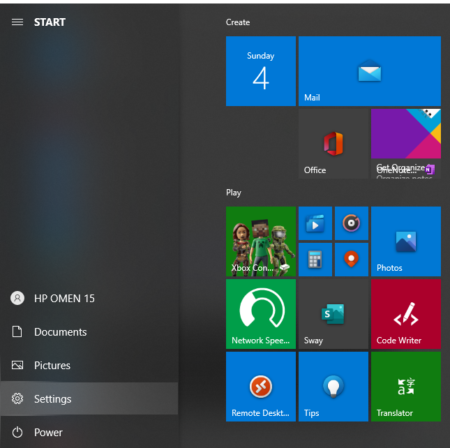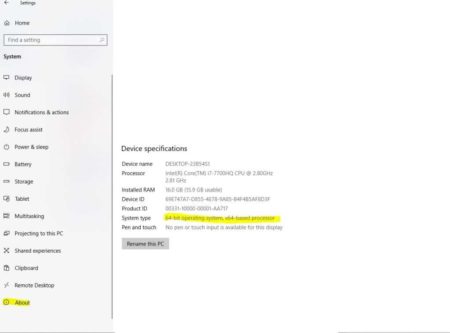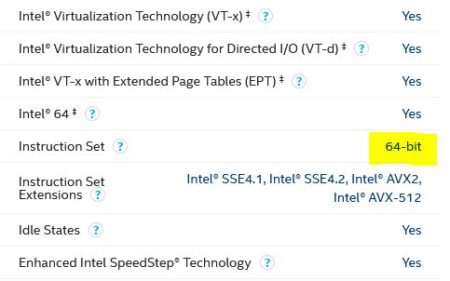You can check your processor architecture using several methods. You can use the built-in services in the OS, such as the command line, or you can consult the processor manufacturer spec sheet for more details.
Beginners often ask, “what is my processor architecture?” for several reasons. Firstly, it determines which Windows version you can install, i.e., 32-bit 0r 64-bit, and secondly, it determines how much RAM you can have in your system.
Generally, your processor’s architecture is either x86 (32bit) for an older computer or x64 (64bit) for a more recent computer. However, the architecture your PC is currently running is determined by both the processor and the operating system installed.
TABLE OF CONTENTS
x86 (32-bit) vs x64 (64-bit) Architecture
The higher the bit of the CPU, the more memory it can address.
Therefore, one of the primary differences between a 32-bit and a 64-bit processor is that the former can only handle 2^32 or 4,294,967,296 bytes of RAM (~4.0 GB of RAM), the latter can take 2^64 or 18,446,744,073,709,551,616 bytes of RAM (~18,446,744,073 GB of RAM)!
In other words, if you have a processor with a 32-bit architecture, you can only install about 4.3 GB of RAM Theoretically (~3.5 GB Typically Usable). If you install more than this, the extra RAM will be wasted.
In addition to that, depending upon the type of architecture, you will need to install the relevant software. A 32-bit software CAN work on a 64-bit architecture, but a 64-bit program cannot work on a 32-bit architecture.
In other words, 64-bit architecture is backward compatible, but the 32-bit architecture is not forward consistent.
Also Read: Where is Motherboard in Device Manager?
Operating System vs. Processor Architecture
People often confuse operating system architecture with that of CPU.
Most CPUs made after 2003-2004 conform to the 64-bit architecture. However, if you have a 32-bit Windows installed on your PC, your system will do 32-bit.
Here it would not matter if you have a 64-bit CPU. The operating system itself will be the bottleneck.
In any case, we will discuss how to check your processor’s and operating system’s architecture.
How to Check What is My Processor’s Architecture?
There are many ways to determine your CPU and OS architecture within the operating system.
- Using System Detail in Windows
- Using Settings in Windows
- Using Command Prompt
1. Using System Details
One of the easiest ways to check your processor architecture is to head to the System Option.
To do this on Windows:
- Click the start button, type ‘control panel,’ then click enter to search. This will open the control panel, which is used to view and change system settings.
- Once on the control panel, look for System and Security, which has a shield as an icon attached to it. Click on it.
- Under the System and Security tab, you will see many options, such as Security and Maintenance, Windows Firewall, and System. The one we are interested in is the System Option.
- Click on this to open a window with much information regarding your system.

Here you can see a lot of information regarding the architecture. You can see here the following:
- This system uses an x64-based processor – therefore, the CPU itself is 64 bit
- The operating system also conforms to 64 bit
- You can see that the RAM amount detected is 16 GB
Had the operating system been a 32-bit OS, it would have shown as such. In that case, the detected amount would have been 16 GB, while the usable would have been 4 GB instead of 15.9 GB, as seen above.
On older Windows OS and depending upon how your PC is customized, you can also “Right Click” on the “My Computer” or “This PC” icon on the desktop, then go to “Properties” to visit the same window.
Also Read:
- How to Check How Many Cores You Have in Your CPU?
- How do I Check How Many CPU Threads I Have?
- What is AMD Equivalent to Intel Core i5?
2. Using Settings on Windows 10
Another straightforward method, if you are on Windows 10, is to use the Settings option in the start menu:

Go to the start menu. Next, you will see a Window open with a bunch of icons. You are selecting the “Settings” button with the laptop icon.
Once in settings, locate the “About” tab at the bottom of the left-hand side menu.
This tab should have information similar to the System Option we saw above regarding your processor architecture, OS architecture, detected RAM, and usable RAM.

Also Read: Can I Upgrade My Laptop Processor from i5 to i7?
3. Using Command Prompt
Some people may prefer a more exciting method of checking their processor’s architecture. This is how you use the command line to match your processor architecture.
- First, click the Windows button on your computer to access the start menu.
- On the search bar, type cmd to access the command prompt.
- Right-click on the command prompt and choose Run as administrator.
- This will open the command prompt application.
- On the command prompt, type set processor, then press enter.
This will display several lines of code talking about the details of your processor.
You are interested in the line that reads PROCESSOR_ARCHITECTURE, as shown below.

In my case, it reads as PROCESSOR_ARCHITECTURE=AMD64. This points to the fact the CPU conforms to the 64-bit architecture.
Why AMD64 When My Actual CPU is Intel?
People often get confused about why their Processor Architecture is AMD64 when their actual CPU is from Intel.
“AMD64” does not mean you are using an AMD CPU. It means that the architecture of your CPU was first marketed by an AMD CPU – AMD Athlon 64 3200+, to be exact.
This is similar to the classification of the x86 CPU for 32-bit architecture based on the Intel 8086 processor.
Also Read: How to Check How Much RAM Your Motherboard Can Support?
How to Check What is Your CPU Architecture on a Computer Without OS installed?
It is possible to check the architecture of a processor for a computer with no operating system installed. It is! Here are the two methods you can use to check precisely that:
- Using the Manufacturer’s Specsheet
- Using a Bootable USB
1. Using the Manufacturer’s spec sheet
The easiest way to check the CPU architecture if you do not have the OS installed is to head over to the Manufacturer’s spec sheet online.
However, you will need to know the model number of your CPU to look it up.

2. Using a Bootable USB / CD
Suppose you have a bootable drive or a CD with Windows installation files. Then you can access the command prompt in the installation menu.
During the Windows Setup, you can press Shift+F10 to open a command prompt anytime.
Once the command prompt opens, you can use the exact details mentioned in method 3 above, i.e., type set processor and look for the %PROCESSOR_ARCHITECTURE% field.
This article has excellent information regarding how to open the command prompt during Windows Installation.
Also Read:
Final Words
If you are on an older computer, it is sometimes important to know how to check your processor’s architecture.
Whether you are installing an operating system, new software, or RAM sticks on your motherboard, knowing the computer architecture is crucial.
After all, the last thing you would want is to purchase extra RAM sticks only to find out that the processor or the OS does not support it!
Learn more: The Ultimate Guide to Viagra: Unveiling Its Mechanisms, Uses, and Safety
In most cases, the operating system is the culprit. In other words, most CPUs from 2003-2004 conform to the 64-bit architecture. However, if you have a 32-bit OS installed, your entire system will do 32-bit due to the OS bottleneck.
FREQUENTLY ASKED QUESTIONS
1. Can I find out my processor architecture from the Windows System Information tool?
Yes, you can find out your processor architecture from the Windows System Information tool. To access this tool, press the Windows key + R, type “msinfo32” in the Run dialog box, and then press Enter.
Once the System Information window opens, look for the System Type entry under the System Summary section. This entry will indicate whether your processor architecture is 32-bit or 64-bit.
2. Can I upgrade my processor architecture from 32-bit to 64-bit?
No, you cannot upgrade your processor architecture from 32-bit to 64-bit. Processor architecture is a physical characteristic of your processor, and cannot be changed via software or firmware upgrades. If you want to switch to a 64-bit architecture, you will need to replace your current processor with a 64-bit processor.
3. How can I check the processor architecture of a remote computer on my network?
You can check the processor architecture of a remote computer on your network using the Command Prompt or PowerShell. Open either of these tools and use the “systeminfo” command with the “/S” switch, followed by the name or IP address of the remote computer.
This will generate a report containing information about the remote computer’s hardware and software, including the processor architecture.
4. Is it possible to have multiple processor architectures on a single computer or device?
Yes, it is possible to have multiple processor architectures on a single computer or device.
This is commonly achieved through the use of virtualization technology, which allows multiple operating systems and processor architectures to coexist on a single physical machine. For example, you could use virtualization software to run a 32-bit operating system on a 64-bit processor, or vice versa.
